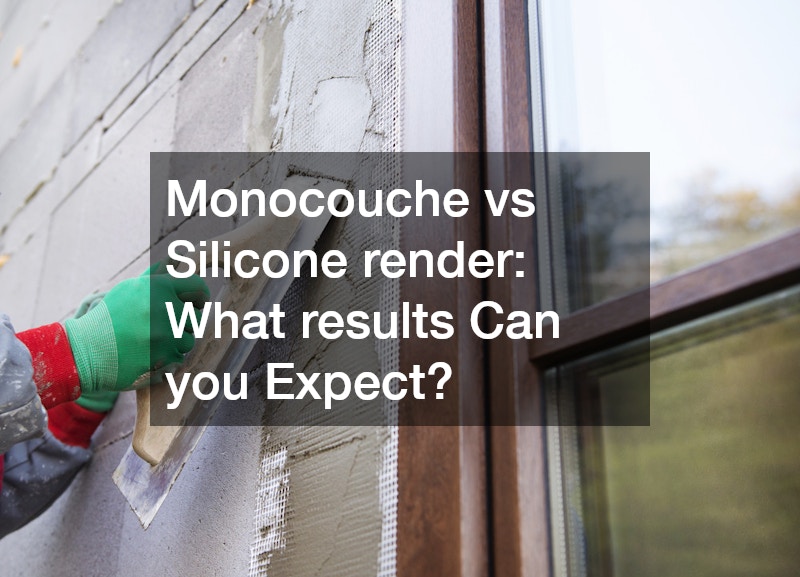In recent years, building aesthetics and durability have become major concerns for homeowners and builders alike. With numerous rendering options available, understanding their differences has become crucial in making informed choices. This article examines two popular options: monocouche and silicone render. We will compare their properties, benefits, application processes, and maintenance needs to help you decide the best option for your project.
What Are the Main Differences Between Monocouche and Silicone Render?
Composition and Characteristics
Monocouche render is primarily a cement-based system often mixed with lime and other minerals, providing a durable and breathable finish. In contrast, silicone render is a synthetic material known for its flexible and hydrophobic properties, making it distinctly resistant to water penetration.
The lime in monocouche allows it to settle and calcify, enhancing its ability to withstand structural movement. Meanwhile, silicone render can absorb and expel moisture, preventing build-up within the substrate, which is crucial for maintaining structural integrity over time.
The differences in composition also lead to varied performance; monocouche is typically thicker, offering a solid coverage compared to the finer finish of silicone renders. These characteristics influence performance and aesthetic versatility, with silicone allowing for a greater variety of colors thanks to its compatibility with advanced pigmentation.
Aesthetic Differences
Monocouche renders generally provide a classic, natural appearance due to their mineral content, which can complement more traditional architectural styles. Its textured finish can add depth and interest to surfaces, enhancing the natural environment of a property.
Silicone renders, on the other hand, are often chosen for modern designs due to their sleek and smooth surface finish. The range of textures available with silicone render allows for a tailored visual appeal, aiding in achieving specific design visions for contemporary buildings.
Despite their distinct visual attributes, both render options rely heavily on proper application techniques to reveal their true aesthetic potential. Poor application can deteriorate each render type’s aesthetic benefits, emphasizing the need for skilled professionals.
How Does the Application Process Differ for Each Render?
Steps Involved in Monocouche Application
The application of monocouche render begins with cleaning and preparing the substrate to remove contaminants that may hinder adherence. Following preparation, the render is machine-applied in two coats, requiring a precise consistency to prevent issues such as cracking.
After the render is applied, a mesh may be embedded to reinforce areas prone to movement or cracking. Afloat is then used to achieve the desired surface texture, with drying times highly dependent on weather conditions and substrate moisture levels.
The effort in applying monocouche render is balanced by its single-layer system, which reduces the need for extensive undertakings. Despite its convenience, it requires an experienced hand to ensure the evenness and structural adhesion essential for longevity.
Steps Involved in Silicone Render Application
Silicone render application starts with ensuring that the base layer is level, to which a primer coat is applied for enhancing adhesion and color uniformity. The following installation of base and reinforcing mesh stabilizes the substrate before the silicone render is applied.
Unlike monocouche, silicone render is usually applied in a very thin layer over a base coat that already possesses some of the overall thickness needed. This makes it crucial during application to adhere to manufacturer guidelines regarding thickness to optimize flexibility and weather resistance.
The application, paired with a quick drying time, reduces potential downtime in construction timelines, a key factor for projects with strict schedules. Despite the more streamlined process, the crucial layering and allowance for curing call for professional oversight.
Which Render Offers Better Durability and Weather Resistance?
Durability Analysis of Monocouche Render
Monocouche render is regarded for its robust nature. Due to its mineral composition, it is substantially resistant to cracking and chipping. The incorporation of materials like lime aids in its adaptation to temperature fluctuations, keeping structural damage at bay.
However, monocouche can be susceptible to environmental staining and algae growth in damp conditions. This limitation is common where high porosity allows biological growth, requiring specific treatment or maintenance strategies to counteract.
Given its capability to withstand structural movement, monocouche is a durable choice in various settings. Nevertheless, inadequate maintenance can challenge its durability, making regular inspection and care critical for its integrity.
Durability Analysis of Silicone Render
Due to its hydrophobic surface, silicone render shines with its weather-resistant properties, particularly in moisture-prone environments. This capability drastically reduces the risk of damp-related issues, such as mold and algae growth.
Additionally, its UV resistance minimizes fading and chalking over time, empowering structures with lasting color vibrancy. Its flexibility also affords it the capability to endure substrate movement without cracking in response to thermal expansions and contractions.
These attributes collectively render silicone a preferred choice for areas exposed to harsh weather. Nevertheless, its reliance on proper installation implies that compliant application methods are indispensable to fully leverage its resistance to environmental factors.
What Are the Maintenance and Longevity Expectations for Each Render?
Maintenance Requirements for Monocouche Render
The maintenance of monocouche render involves regular cleaning to prevent the build-up of dirt and grime, which can deteriorate its surface appearance. Issues such as cracking or efflorescence might necessitate specialized treatments if they arise.
An annual inspection will help identify any emerging problems, allowing for timely intervention to maintain the render’s performance. Professional assessments can prolong its lifespan, offering a cost-efficient approach by addressing potential concerns early.
While maintenance can keep monocouche render looking its best, it is less intensive compared to non-breathable finishes. Ensuring proper ventilation and drainage can also prevent significant water coloration, maintaining its aesthetic appeal over time.
Maintenance Requirements for Silicone Render
Silicone render boasts low maintenance requirements, a significant advantage in keeping ongoing costs manageable for building owners. Its self-cleaning properties allow it to shed dirt and debris naturally, reducing the need for frequent cleaning interventions.
When maintenance is required, typically involving mildew or algae removal, it is often less invasive and time-consuming. Occasional washing with a mild solution can preserve the render’s appearance, while adherence to manufacturer instructions helps sustain its longevity.
Regular evaluation ensures that it remains intact and visually appealing without pronounced restoration efforts. Silicone’s inherent durability often results in lessening the frequency of repairs, contributing to a favorable return on investment over its lifecycle.
Conclusion
Both monocouche and silicone renders offer distinct advantages depending on your building needs. While monocouche is lauded for its aesthetic appeal and ease of application, silicone render provides superior flexibility and weather resistance. By appreciating their composition, application, durability, and maintenance differences, you can select the render that best aligns best with your requirements, ensuring both durability and beauty for your building’s exterior.
.




